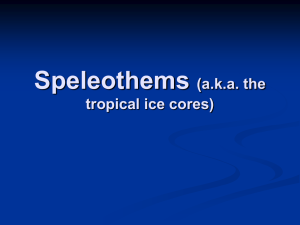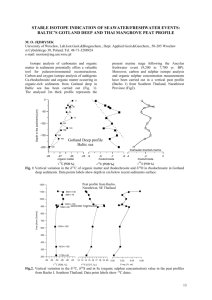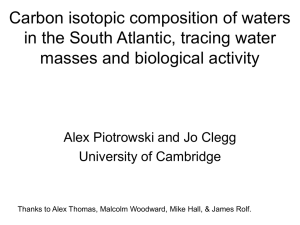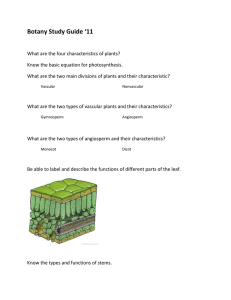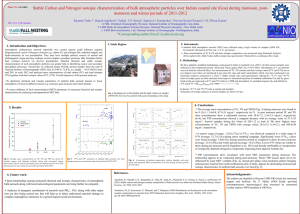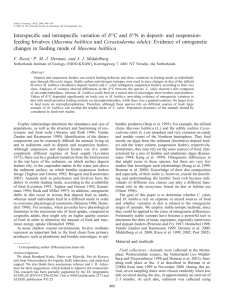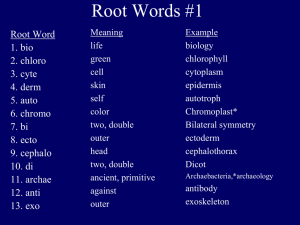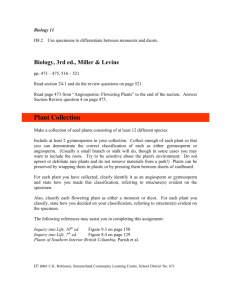C and dD compositions of n-alkanes from d
advertisement
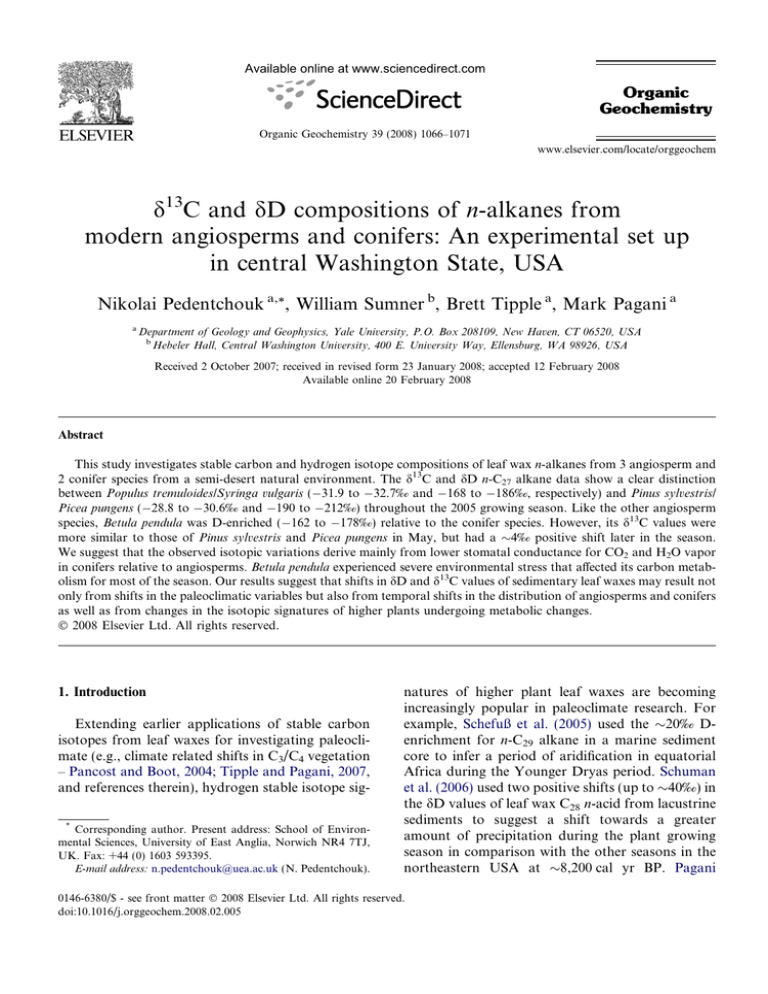
Available online at www.sciencedirect.com Organic Geochemistry Organic Geochemistry 39 (2008) 1066–1071 www.elsevier.com/locate/orggeochem d13C and dD compositions of n-alkanes from modern angiosperms and conifers: An experimental set up in central Washington State, USA Nikolai Pedentchouk a,*, William Sumner b, Brett Tipple a, Mark Pagani a a Department of Geology and Geophysics, Yale University, P.O. Box 208109, New Haven, CT 06520, USA b Hebeler Hall, Central Washington University, 400 E. University Way, Ellensburg, WA 98926, USA Received 2 October 2007; received in revised form 23 January 2008; accepted 12 February 2008 Available online 20 February 2008 Abstract This study investigates stable carbon and hydrogen isotope compositions of leaf wax n-alkanes from 3 angiosperm and 2 conifer species from a semi-desert natural environment. The d13C and dD n-C27 alkane data show a clear distinction between Populus tremuloides/Syringa vulgaris ( 31.9 to 32.7‰ and 168 to 186‰, respectively) and Pinus sylvestris/ Picea pungens ( 28.8 to 30.6‰ and 190 to 212‰) throughout the 2005 growing season. Like the other angiosperm species, Betula pendula was D-enriched ( 162 to 178‰) relative to the conifer species. However, its d13C values were more similar to those of Pinus sylvestris and Picea pungens in May, but had a 4‰ positive shift later in the season. We suggest that the observed isotopic variations derive mainly from lower stomatal conductance for CO2 and H2O vapor in conifers relative to angiosperms. Betula pendula experienced severe environmental stress that affected its carbon metabolism for most of the season. Our results suggest that shifts in dD and d13C values of sedimentary leaf waxes may result not only from shifts in the paleoclimatic variables but also from temporal shifts in the distribution of angiosperms and conifers as well as from changes in the isotopic signatures of higher plants undergoing metabolic changes. Ó 2008 Elsevier Ltd. All rights reserved. 1. Introduction Extending earlier applications of stable carbon isotopes from leaf waxes for investigating paleoclimate (e.g., climate related shifts in C3/C4 vegetation – Pancost and Boot, 2004; Tipple and Pagani, 2007, and references therein), hydrogen stable isotope sig* Corresponding author. Present address: School of Environmental Sciences, University of East Anglia, Norwich NR4 7TJ, UK. Fax: +44 (0) 1603 593395. E-mail address: n.pedentchouk@uea.ac.uk (N. Pedentchouk). natures of higher plant leaf waxes are becoming increasingly popular in paleoclimate research. For example, Schefuß et al. (2005) used the 20‰ Denrichment for n-C29 alkane in a marine sediment core to infer a period of aridification in equatorial Africa during the Younger Dryas period. Schuman et al. (2006) used two positive shifts (up to 40‰) in the dD values of leaf wax C28 n-acid from lacustrine sediments to suggest a shift towards a greater amount of precipitation during the plant growing season in comparison with the other seasons in the northeastern USA at 8,200 cal yr BP. Pagani 0146-6380/$ - see front matter Ó 2008 Elsevier Ltd. All rights reserved. doi:10.1016/j.orggeochem.2008.02.005 N. Pedentchouk et al. / Organic Geochemistry 39 (2008) 1066–1071 et al. (2006) interpreted the 55‰ increase in the dD values of n-C27/29 alkanes as reflecting decreased rainout during moisture transport from lower latitude and, as a result, increased moisture delivery to the Arctic at the onset of the Paleocene/Eocene thermal maximum. Additionally, the 4.5 to 6‰ shift in the d13C values of these compounds was used by the authors to argue for a substantially larger negative shift in the d13C values of atmospheric CO2 than reported previously. The spatial distribution of angiosperms and conifers is controlled by regional climate (e.g., Woodward, 1992) and is susceptible to climate change, even at the millennial and submillennial timescales (Tinner and Lotter, 2001; Williams et al., 2004). Thus, interpretation of leaf wax d13C and dD paleodata depends strongly on understanding the relative contribution and isotopic signatures of angiosperm and conifer plants in the sedimentary record. The importance of these variables was recently highlighted by Smith et al. (2007), who argued that a shift from a mixed angiosperm/conifer to a purely angiosperm plant community led to an amplified d13C signal (4–5‰, leaf wax n-alkanes in the Bighorn Basin, Wyoming, USA) in comparison with that typically recorded by marine carbonates for the carbon isotopic excursion during the Paleocene/Eocene thermal maximum. Simultaneous investigation of d13C and dD values of leaf wax lipids could become a powerful tool for deciphering the dynamics of angiosperm and conifer communities in the sedimentary record, because of differences in stomatal structure between these plant types (Esau, 1977) and, as a result, potential differences in their isotopic signatures. Only a few studies have investigated leaf wax d13C and dD values of modern angiosperms and conifers simultaneously. These studies did not reveal clear differences in the d13C/dD signal. Chikaraishi and Naraoka (2007) observed no trend among angiosperm and conifer species collected from a number of sites in Japan and Thailand. Hou et al. (2007) observed a weak trend in d13C/dD values of plants with different water use efficiency (as was assumed by the authors based on d13C relationship among the plants) near Blood Pond, Massachusetts, USA, but the trend did not reveal clear differences between angiosperms and conifers. In this study, we report d13C and dD compositions of leaf wax n-alkanes from several angiosperm and conifer species sampled during May–October 2005 near Kittitas, central Washington State, 1067 USA. Our first data from this well-controlled experimental set up in a climatically stressful, semi-desert natural environment provide initial information for interpreting stable isotope signatures of higher plants that existed in such paleoenvironments. 2. Materials and methods The climate in the study area is characterized as dry, with four definite seasons, and <10 cm of precipitation from May to October (Kittitas Country, 2004). Well water, drawn from 95 m depth, was the most important source of moisture for the plants under investigation during the sampling period. We sampled 3 angiosperm (Betula pendula, Populus tremuloides and Syringa vulgaris) and 2 gymnosperm (Pinus sylvestris and Picea pungens) plants. All five plants are approximately the same age (7–8 years old as of 2005), grow outdoors in close proximity to each other (<10 m apart) and receive an equal amount of sunlight. Trees were watered at the same time (over a period of 2–3 h) once or twice a week. Each tree received, on average, about 70 l. The water disappeared into the ground after 30 min. or less. No soil moisture measurements were carried out during 2005, so no quantitative data are available for estimating evaporative losses subsequent to watering of individual plants. Relative humidity and temperature were monitored using a VERITEQ SP-2000-20R logger installed in the shade, 2 m above ground. Fourteen well water and 7–10 leaf (or 3 shoots for conifers) samples per each tree were sampled from May to October 2005. Leaf samples were extracted with hexane by sonication (30 min 2). Lipid fractions were separated via column chromatography (70–230 mesh) using a hexane, hexane/dichloromethane (DCM; 9:1 v/v) and DCM/MeOH (2:1 v/v) sequence. The hexane fraction was analyzed for d13C and dD compositions using a Thermo Finnigan MAT 253 mass spectrometer interfaced to a Thermo Finnigan Trace GC Combustion III interface (for d13C) and a high temperature conversion (for dD) systems. The dD values of well water samples were determined using the same instrument interfaced with a H-device. Individual n-alkanes were separated using a J&W Scientific DB-1 column (60 m 0.25 mm 0.25 l film thickness). The GC oven was programmed from 60 °C (1 min) at 6 °C/min to 320 °C (25 min). The d13C values are expressed relative to Vienna Pee Dee belemnite (VPDB), based on an in-house reference gas calibrated against the 1068 Table 1 Isotopic compositions of leaf-wax n-alkanes and well water in 2005, central Washington State, USA (d13C and dD values are in ‰ relative to VPDB and VSMOW, respectively; numbers in parenthesis represent an error (±) based on duplicate analyses) Plant species 27 May Betula pendula nC25 30.3(0.6) nC27 30.1(0.1) nC31 32.2(0.1) Syringa vulgaris nC27 32.4(0.1) nC29 32.3(0.3) nC31 33.2(0.4) 33.3(0.2) nC33 Populus tremuloides nC23 n.d. nC25 31.7(0.1) 32.0(0.0) nC27 Pinus sylvestris nC25 28.2(0.0) 28.8(0.1) nC27 nC29 28.5(0.0) nC31 30.3(0.0) Picea pungens nC23 29.8(0.0) nC25 30.3(0.0) nC27 30.6(0.0) nC29 29.9(0.1) 32.3(0.0) nC31 Date Well water, dD 03/07 103(0) 3 July 24 July 27 September 23 October d13C d13C d13C dD 188(4) 163(4) n.d 26.7(0.0) 26.7(0.0) n.d. 187(11) 166(2) n.d. 28.1(0.2) 27.9(0.0) 32.0(0.1) 165(5) 162(3) 144(10) 26.6(0.1) 26.9(0.0) 30.7(0.0) 177(2) 172(3) 149(2) 26.3(0.1) 26.6(0.1) 31.1(0.0) 174(8) 175(3) 163(3) 25.6(0.0) 26.3(0.1) 31.4(0.0) 182(1) 178(2) 166(2) 26.7(0.1) 26.1(0.1) 31.7(0.0) 169(6) 171(1) 155(1) 168(4) 186(2) 199(1) 203(0) 32.3(0.3) 32.5(0.1) 33.6(0.1) 33.5(0.1) 176(1) 196(1) 215(0) 212(1) 32.2(0.2) 32.6(0.3) 33.3(0.0) 33.4(0.1) 176(1) 192(1) 210(1) 209(1) 32.0(0.1) 32.6(0.0) 34.2(0.1) 34.2(0.1) 175(1) 192(0) 209(1) 209(1) 32.7(0.0) 33.4(0.3) 34.6(0.1) 34.6(0.0) 178(1) 195(0) 208(0) 209(1) 32.2(0.1) 32.5(0.3) 33.1(0.0) 33.2(0.1) 177(1) 190(2) 217(1) 206(0) 32.4(0.4) 32.6(0.1) 33.7(0.1) 33.5(0.1) 177(1) 188(1) 206(2) 206(1) 171(2) 178(2) 169(4) 33.1(0.1) 32.5(0.0) 32.5(0.1) 178(3) 180(1) 179(1) 33.5(0.1) 32.7(0.1) 32.7(0.1) 172(3) 176(1) 177(2) 33.2(0.1) 32.7(0.1) 32.3(0.0) 166(4) 175(4) 177(4) 32.8(0.1) 32.3(0.0) 31.9(0.1) 180(1) 180(2) 183(2) 33.0(0.0) 32.5(0.0) 32.3(0.0) 181(4) 184(4) 186(3) 33.7(0.0) 33.2(0.2) 32.7(0.0) 175(1) 178(1) 181(1) 184(0) 191(2) 208(3) 194(1) 30.3(0.0) 30.6(0.0) 28.8(0.0) 31.4(0.3) 186(2) 195(1) 210(1) 192(5) 29.8(0.1) 29.2(0.0) 27.6(0.1) 29.5(0.1) 184(4) 193(1) 209(1) 189(3) 29.1(0.1) 29.2(0.1) 28.4(0.0) n.d. 179(1) 190(3) 205(4) 185(2) 29.4(0.0) 29.4(0.1) 28.8(0.1) 29.8(0.0) 185(3) 194(1) 208(1) 190(4) 30.0(0.1) 29.9(0.1) 29.5(0.0) 31.3(0.2) 191(1) 196(1) 210(1) 196(0) 29.2(0.1) 29.1(0.0) 28.4(0.0) 29.9(0.1) 187(1) 193(0) 202(1) 182(4) 186(9) 206(1) 203(1) 210(5) n.d 30.0(0.0) 30.8(0.1) 29.9(0.0) 28.6(0.1) 29.9(0.0) 190(0) 212(5) 212(1) 212(2) 194(4) 29.8(0.1) 30.1(0.0) 29.1(0.0) 27.7(0.0) 28.9(0.1) 173(3) 207(3) 208(1) 213(1) 193(5) 30.0(0.0) 30.7(0.0) 29.8(0.0) 28.5(0.1) 30.1(0.1) 167(7) 204(1) 204(4) 211(2) 188(1) 29.5(0.0) 30.3(0.1) 30.0(0.1) 28.8(0.0) 30.2(0.1) 183(11) 207(6) 207(2) 214(4) n.d. 29.7(0.0) 30.4(0.0) 29.8(0.1) 28.4(0.1) 30.0(0.1) 190(1) 210(0) 212(1) 216(2) 198(3) 28.9(0.0) 30.0(0.0) 29.3(0.0) 27.9(0.0) 29.5(0.1) 185(11) 201(8) 202(2) 202(7) n.d. 24/07 103(0) 28/07 102(0) 01/08 105(0) dD 06/08 104(0) d13C 14 September d13C 08/07 103(0) d13C 24 August dD 13/08 102(1) dD 24/08 104(1) 29/08 102(0) dD 14/09 104(0) 20/09 102(0) dD 27/09 103(0) 06/10 104(0) dD 24/10 103(0) N. Pedentchouk et al. / Organic Geochemistry 39 (2008) 1066–1071 d13C N. Pedentchouk et al. / Organic Geochemistry 39 (2008) 1066–1071 OzTech standard (d13C = 40.61‰). The margin of error for sample n-alkane d13C measurements was ±0.6‰ or better (Table 1). Pyrolytic conversion of organic hydrogen to H2 was conducted at 1400 °C. Hydrogen isotopic compositions of n-alkanes are expressed relative to Vienna Standard Mean Ocean Water (VSMOW) based on an in-house reference gas adjusted daily using a 5a-androstane standard. The margin of error for sample n-alkane dD measurements was generally better than ±5‰, reaching ±11‰ in only a few cases (Table 1). Hydrogen isotopic compositions of well water samples are expressed relative to VSMOW and are normalized to Greenland Ice sheet Precipitation (GISP) and Standard Light Antarctic Precipitation (SLAP). The margin of error for well water dD measurement was ±1‰ or better. 3. Results and discussion The 2005 data from central Washington State are shown in Table 1. Because n-C27 alkane was the only compound present in sufficient quantities in all five species for reliable d13C/dD measurements, we restrict our discussion to this component. The n-C27 alkane data show clear separation between 2 conifers and 2 angiosperms (Fig. 1). From May to October, d13C and dD values of Syringa vulgaris and Populus tremuloides stayed within 31.9 to 32.7‰ and 168 to 186‰, respectively, showing a minor trend towards more D-depleted values at the end of the growing season (Fig. 2). However, d13C and dD values for Pinus sylvestris and Picea pungens ranged between 28.8 and 30.6‰, and Fig. 1. The d13C and dD values of n-C27 alkane from five plant species, central Washington State, USA. 1069 between 190 and 212‰, with no major trend. Like the other angiosperm species, B. pendula was D-enriched ( 162 to 178‰) relative to the conifer species. However, d13C values of B. pendula were more similar to those of Pinus sylvestris and Picea pungens in May, and had a positive 4‰ shift from May to October, thus becoming even more 13Cenriched in comparison with the other angiosperms by the end of the growing season. Because all five plants experienced the same environmental conditions and were irrigated with the same water, we suggest that the observed isotopic variations derive mainly from physiological differences. Relative 13C-enrichment and D-depletion for P. sylvestris and P. pungens could have resulted from their lower stomatal conductance for CO2 and H2O vapor and thus greater water use efficiency (WUE) in comparison with Syringa vulgaris and P. tremuloides. We currently have no field data for stomatal conductance for the plants, but published studies – either for the same species (P. sylvestris and P. tremuloides) or for the species from the same genus (P. sitchensis and B. alleghaniensis) – show lower stomatal conductance in conifers relative to angiosperms in outdoors environments (Körner et al., 1979; Fig. 3). Apparent hydrogen fractionation factor between n-C27 alkane and well water used for irrigation (Fig. 4) provides further evidence for physiological differences between angiosperm and conifer species in our study. Assuming that biosynthetic fractionation between n-C27 alkane and water is constant, species with greater stomatal conductance would experience greater evaporative D-enrichment of leaf water through transpiration, consistent with our observations for Syringa vulgaris and P. tremuloides in comparison with Pinus sylvestris and Picea pungens. Our results indicate a much wider range of apparent hydrogen fractionation factors for both angiosperm and conifer species (ranging between ca. 120 and 65‰, Fig. 4) than previously reported (Chikaraishi and Naraoka, 2003; Bi et al., 2005; Sachse et al., 2006). These other studies estimate rather invariable and more negative apparent hydrogen fractionation factors (ca. 120‰) for both types of plants. The stark differences between our study and previous works could be attributed to the fact that our experimental design in eastern WA state represents an unusually dry environment in comparison with that typically experienced by the species used in this study. Thus, our data may 1070 N. Pedentchouk et al. / Organic Geochemistry 39 (2008) 1066–1071 Fig. 2. Seasonal variability in d13C and dD values of n-C27 alkane from five plant species, and dD of well water during 2005, central Washington State, USA. Fig. 3. Maximum stomatal diffusive conductance. Data from Körner et al. (1979). Gray shaded pattern – conifer species, diagonal lines – angiosperm species. represent an extreme case, so generalization of these results should be done with caution. It is not clear why B. pendula displays such a different trend in d13C values in comparison with the other angiosperm species. One possible explanation is that B. pendula, typically accustomed to moist soil in a more humid northern climate, experienced severe environmental stress, with the worst effects in July–August when the relative humidity was lowest. This stress could have affected carbon metabolism in B. pendula for the rest of the season. Fig. 4. Apparent fractionation factor (e) between average n-C27 alkane dD values of five plant species and well water; en-C27/w = ((R n-C27/Rw 1) 1000‰, where R = D/H. The same dDw value was used for each plant species at a particular point in time. Indirect evidence for this comes from the fact that it is the only species that showed a significant increase in the proportion of n-C31 relative to all the other prominent n-alkanes during the growing season (Fig. 5) – a possible mechanism for building a thicker more rigid wax layer to avoid drought (Kozlowski and Pallardy, 1997). N. Pedentchouk et al. / Organic Geochemistry 39 (2008) 1066–1071 1071 References Fig. 5. Proportion of n-C31 alkane relative to the sum of all prominent n-alkanes (n-C25, n-C27, n-C29, and n-C31) from B. pendula leaves collected in 2005, central Washington State, USA. The ratio was calculated based on individual peak areas using GC FID (flame ionization detector) data. 4. Conclusions The initial 2005 results from a semi-desert environment in central Washington State indicate that well-adapted higher plant species maintain relatively constant dD and d13C values of n-alkanes during a single growing season. However, certain poorly adapted species, B. pendula in this case, may undergo large shifts in d13C value due a possible alteration in carbon metabolism under environmental stress. Additionally, the results suggest that shifts in dD and d13C values of sedimentary n-alkanes may result not only from shifts in paleoclimatic variables but also from temporal shifts in the distribution of angiosperms and conifers as well as from changes in the isotopic signatures of higher plants undergoing metabolic changes. Acknowledgements N. Pedentchouk was supported by the Bateman Postdoctoral Fellowship while at Yale University. We thank G. Olack for technical assistance with IRMS analysis. We are grateful to R. Pancost and F. Smith for constructive reviews of the manuscript. Guest Associate Editor—R.D. Pancost Bi, X., Sheng, G., Liu, X., Li, C., Fu, J., 2005. Molecular and carbon and hydrogen isotopic composition of n-alkanes in plant leaf waxes. Organic Geochemistry 36, 1405–1417. Chikaraishi, Y., Naraoka, H., 2003. Compound-specific dD–d13C analyses of n-alkanes extracted from terrestrial and aquatic plants. Phytochemistry 63, 361–371. Chikaraishi, Y., Naraoka, H., 2007. d13C and dD relationship among three n-alkyl compound classes (n-alkanoic acid, nalkane, and n-alkanol) of terrestrial higher plants. Organic Geochemistry 38, 198–215. Esau, K., 1977. Anatomy of Seed Plants, second ed. John Wiley & Sons, Inc. Hou, J., D’Andrea, W.J., MacDonald, D., Huang, Y., 2007. Evidence for water use efficiency as an important factor in determining the dD values of tree leaf waxes. Organic Geochemistry 38, 1251–1255. Kittitas Country, 2004. Kittitas County 2004 Road Atlas. Appendices. Accessible from: <http://www.co.kittitas.wa.us/ publicworks/atlas/Atlas2004_Appendices.pdf>. Körner, C., Scheel, J.A., Bauer, H., 1979. Maximum leaf conductance in vascular plants. Photosynthetica 13, 45–82. Kozlowski, T.T., Pallardy, S.G., 1997. Physiology of Woody Plants, second ed. Academic Press. Pagani, M., Pedentchouk, N., Huber, M., Sluijs, A., Schouten, S., Brinkhuis, H., Sinninghe Damsté, J.S., Dickens, G.R., the IODP Expedition 302 Expedition Scientists, 2006. Arctic hydrology during global warming at the Palaeocene/Eocene thermal maximum. Nature 442, 671–675. Pancost, R.D., Boot, C.S., 2004. The palaeoclimatic utility of terrestrial biomarkers in marine sediments. Marine Chemistry 92, 239–261. Sachse, D., Radke, J., Gleixner, G., 2006. dD values of individual n-alkanes from terrestrial plants along a climatic gradient – implications for the sedimentary biomarker record. Organic Geochemistry 37, 469–483. Schefuß, E., Schouten, S., Schneider, R.R., 2005. Climatic controls on central African hydrology during the past 20,000 years. Nature 437, 1003–1006. Schuman, B., Huang, Y., Newby, P., Wang, Y., 2006. Compound-specific isotopic analyses track changes in seasonal precipitation regimes in the northeastern United States at ca. 8,200 cal yr BP. Quaternary Science Reviews 25, 2992–3002. Smith, F.A., Wing, S.L., Freeman, K.H., 2007. Magnitude of the carbon isotope excursion at the Paleocene–Eocene thermal maximum: the role of plant community change. Earth and Planetary Science Letters 262, 50–65. Tinner, W., Lotter, A.F., 2001. Central European vegetation responsetoabruptclimatechangeat8.2 ka.Geology29,551–554. Tipple, B.J., Pagani, M., 2007. The early origin of terrestrial C4 photosynthesis. Annual Reviews of Earth and Planetary Sciences 35, 435–461. Williams, J.W., Shuman, B.N., Webb III, T., Bartlein, P.J., Leduc, P.L., 2004. Late-quaternary vegetation dynamics in North America: scaling from taxa to biomes. Ecological Monographs 74, 309–334. Woodward, F.I., 1992. A review of the effects of climate on vegetation: ranges, competition, and composition. In: Peters, R.L., Lovejoy, T.E. (Eds.), Global Warming and Biological Diversity. Yale University Press, New Haven & London, pp. 105–123.
